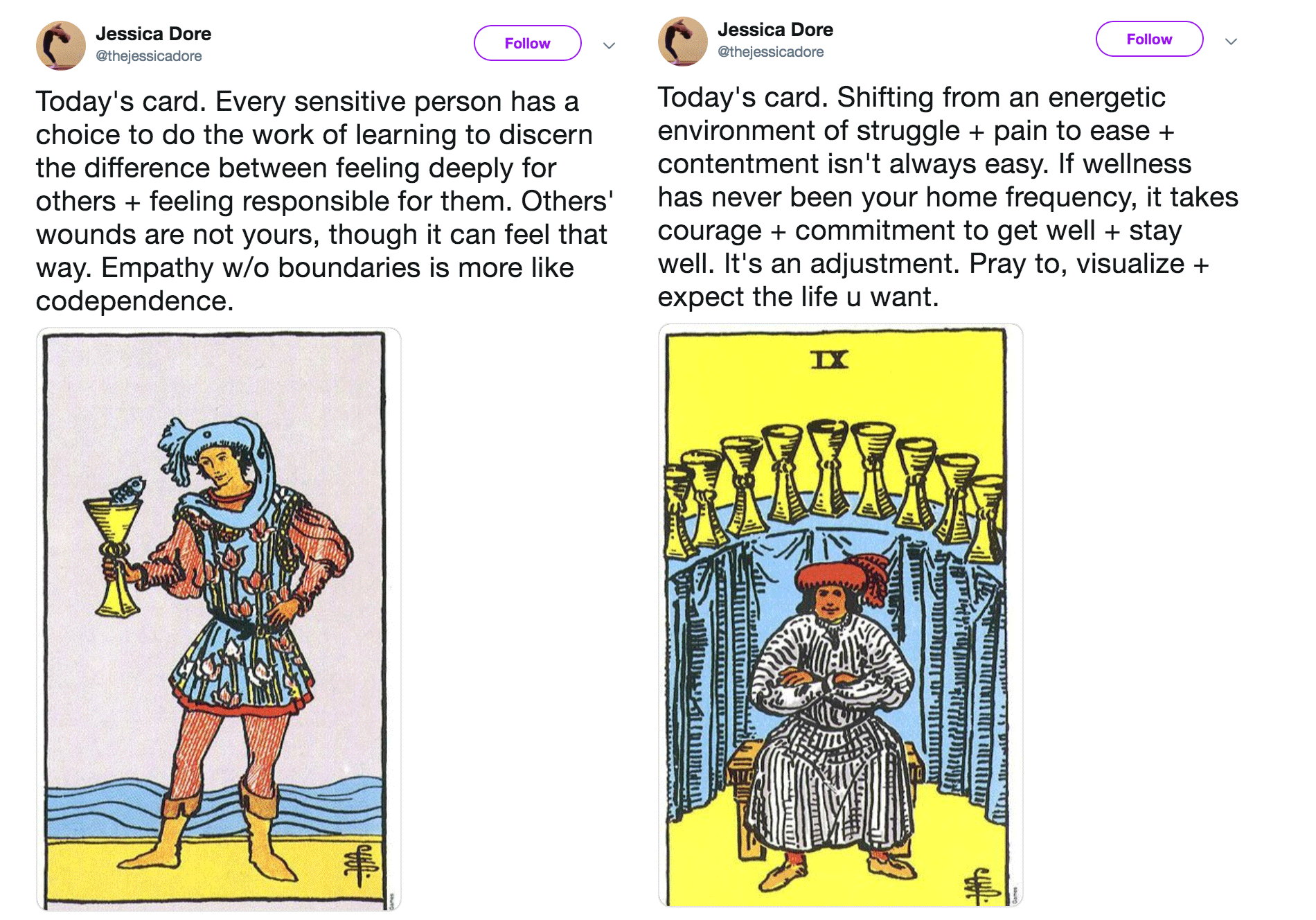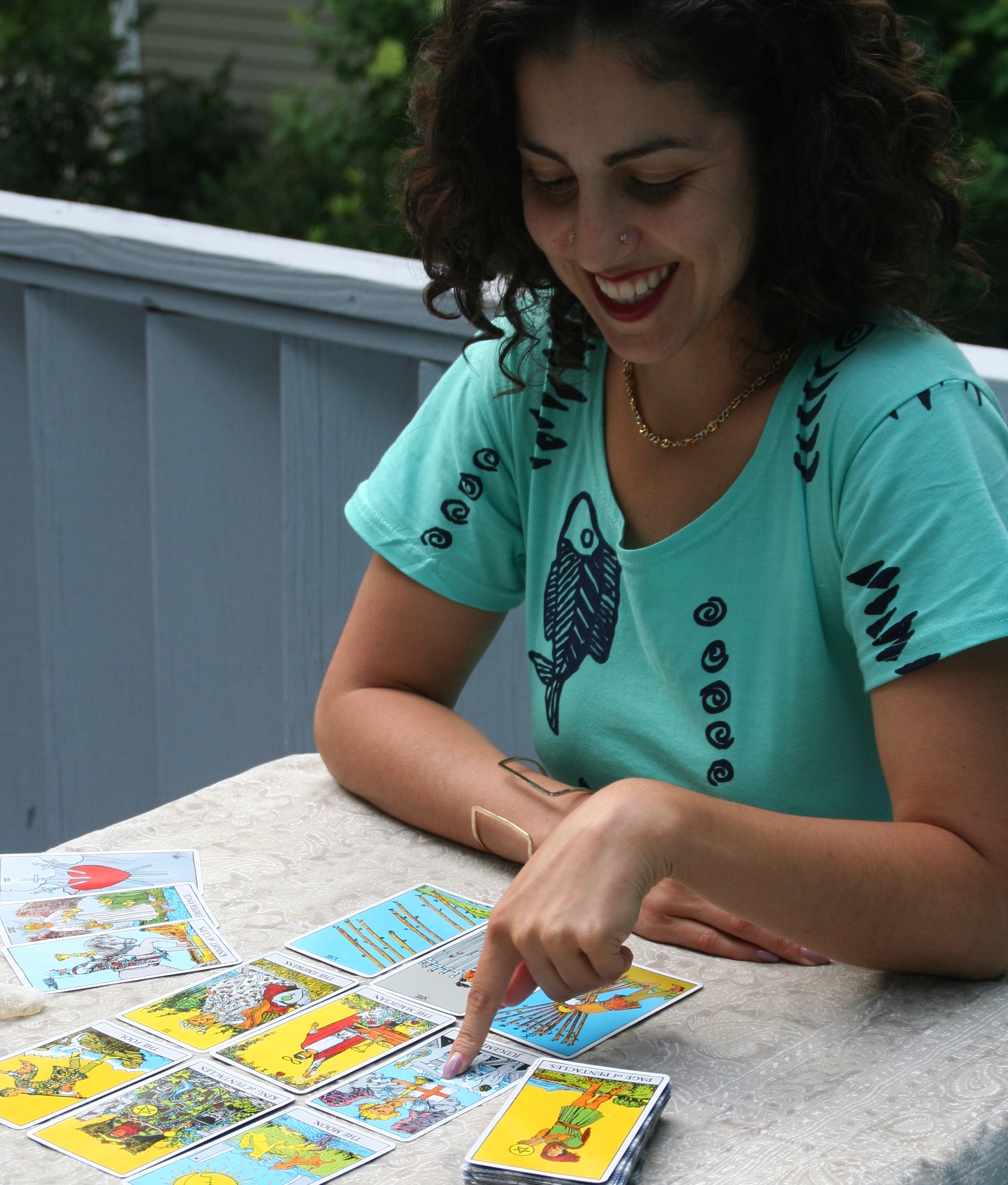This Mental Health Worker Is Using Tarot Cards to Help Her Twitter Followers
Credit to Author: Hannah Ewens| Date: Wed, 20 Mar 2019 15:36:04 +0000
My favourite tarot card was tweeted by Jessica Dore on the 4th of March.
The Nine of Swords: nine blades slicing horizontally in the darkness above a person sitting up in bed, hands over their face. The blades cut through everything, dominating and unavoidable. They look scary, actually. The accompanying text read: “Today’s card. Intrusive thoughts can cause a great deal of stress and anxiety so it is natural to want to get rid of the them. Unfortunately, the more we resist unwanted thoughts, the more power we give them. Try changing your relationship w them. Every thought is not a message.”
I found it comforting that the blades illustrated how intrusive thoughts feel. When they arrive, anything you are doing or thinking is disrupted. The feeling is visceral, forcing you to jolt up, mentally or physically. You might have various thoughts competing against each other, like the parallel layers of blades. The hands to the head represent the distress you feel during, and the ruminating or compulsions that can come as a result.
But there is an alternative to feeling like this, as is explained in the caption: “every thought is not a message”. You don’t have to attribute meaning to these intrusions. What a revelation.
Every day on Jessica Dore‘s Twitter feed, a new tarot card is pulled. It might be the Ace of Swords (a hand holding a silver blade, upon it a crown draped with a wreath); the Five of Pentacles (two beggars fighting their way through the snow, under a stained glass window); or The Lovers (a couple, naked, with an angel blessing them both). This daily card pull is not about divination. They don’t offer a glimpse into the future – unless, I suppose, you’re willing to engage with the messages and change your life as directed. To put teachings in practice.
I started following Jessica online around the end of summer last year, when she had a modest following. I am now completely obsessed – as are many of her 44,000 followers – and find myself refreshing her profile daily between 12PM and 4PM GMT, which is when she usually posts. It is one small no-cost act that makes me feel I am productively integrating mental health care into my day.
I often see people I know favouriting her tweets now – people who, as far as I know, don’t believe in astrology and have no interest in tarot cards or witchcraft or spirituality, but who do, for whatever reason, have a personal interest in mental health, personal development and wellbeing.

Jessica posts captions with her cards that serve as helpful reminders throughout the day. At first glance they might look like the platitudes of a social media influencer, but absorb them properly and you could get something from them. An example: “Black and white thinking is a common response to trauma; after traumatic experience, the brain categorises grey area as uncertain and potentially dangerous. Healing involves re-learning to be in life’s grey areas. Good people sometimes behave badly, and can still be safe.” Another: “One of the simplest ways to practice magic in our lives is through introspection and self-inquiry. Each time we become aware of a pattern – whether it be emotional, behavioural, cognitive, energetic – we initiate an alchemical reaction that alters our being.”
In her early twenties, Jessica lived in California and worked for a book publisher called New Harbinger. They release behavioural therapy books with titles like The CBT (Cognitive Behavioural Therapy) Workbook For Perfectionism and Overcoming Harm OCD, as well as psychology books for mental health professionals.
“For the first few years I was a publicist there, so it was my job to open up these manuals and pull concepts in them and translate them into language that editors at women’s magazines or regular readers could understand,” Jessica tells me over Skype. During that period, she was studying psychology and got her first deck of tarot cards, which she only used on herself, to understand what was going on in her own life. “Learning about the cards alongside all these psychological and therapeutic models at the same time, I saw a lot of connections between the cards and books.” The meanings of those models were baked into how she understood the cards, she tells me.
In 2016, Jessica left her job – where she’d progressed to become an outreach editor – and went to Jamaica for five months. In Kingston, she met other healing communities and found, surprised, that plenty of people loved and practiced tarot there. By this point she had developed her model of fusing card readings with self-help advice, which she started to share on her blog.
Now back in Philadelphia, Jessica is in graduate school, studying social work, and is continuing with the daily card pulls, monthly readings and one-on-one tarot readings.

Tarot and psychology have a long-standing relationship. Psychotherapy was once more of an art than a science, and Carl Jung himself saw links between the two. Academics have researched the benefits of bringing tarot cards into counselling and therapeutic scenarios, as well as the benefits of their solo use for self-reflection. There’s a metaphoric language to tarot cards; when we speak in talking therapy, the sessions are also heavy with metaphor and symbols. What makes Jessica’s work unique is that she is incorporating information from CBT (cognitive behavioural therapy), DBT (dialectical behavioural therapy) and ACT (acceptance and commitment therapy).
“Some people understand through reading, some through seeing, some through looking at an image: that’s real. The more angles we come at to get a point across, the better,” she says, adding that books have been written to guide psychotherapists on how to use metaphor in therapy. She has a hunch that her cards are so popular because she combines ways of understanding and absorbing information.
For instance, when I see the words “intrusive thought” I know what that means, but there’s something about seeing those cold blades slicing through the air that helps me understand what she’s saying, internalise it and process it somehow. It makes me mentally play with the ideas. Something creative happens when you’re consuming the card and the information together.
Each time Jessica posts a card, I look underneath to see what people have written. For me, there’s comfort in knowing others are relating to them. Often, it’s them saying something like “oh my god – seen”, “shook” and “how does she know”. Some days I’ve done the same (although I’d never actually reply,; rather, I just silently mouth something about magic). This amuses her.
“When people see a tarot card they still have the association with magic and fortune telling, but what I’m doing is different,” she says. “I’m talking about things common to the human experience, and that’s a common part of being a human with a brain, and the tarot element of that makes it synchronistic. Without the card, I think people would say, ‘Damn, I needed to hear that.'”
I tell Jessica that what I like about the cards is the fact she uses specific psychological words or terms and then simplifies it all for you, not shying away from any concepts. She says that it was working on those books in her twenties when she realised that the information simply wasn’t accessible.
“Just understanding anxiety disorders or depression or OCD on an intellectual level by reading those books back at my job was helping me with my life,” she explains. “Something like intrusive thoughts – we don’t get educated on. What’s going on here with this mind, body and feelings, and the interaction between them: you shouldn’t need an expensive therapist or a doctoral degree to get access to that information. Mental health understanding is not secret knowledge.”
She’s right. It shouldn’t be, but every daily card pull feels like vital knowledge on your timeline, packaged as a secret gift.
This article originally appeared on VICE UK.